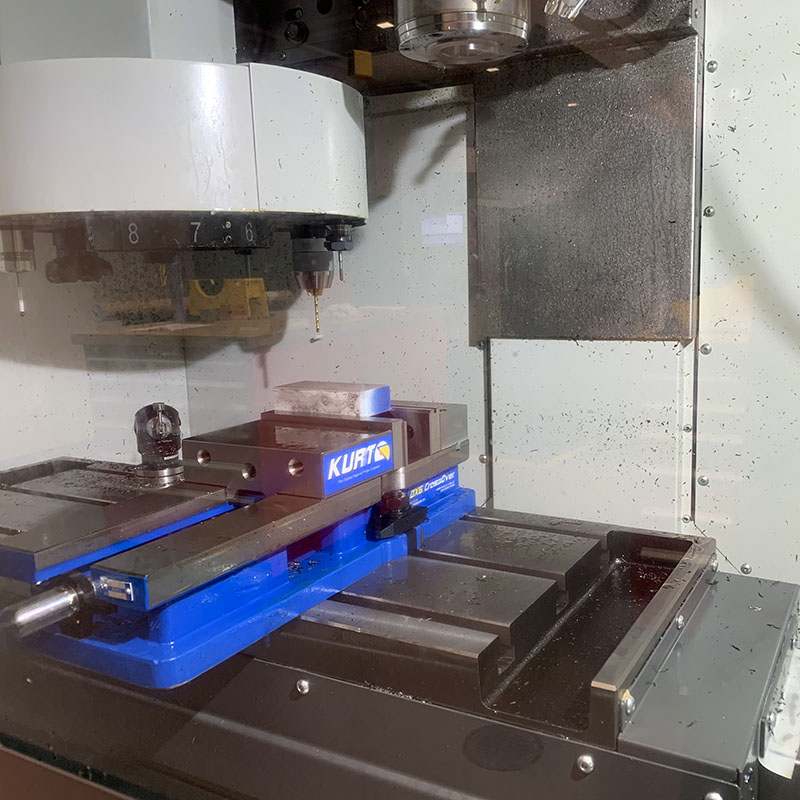One of the developments at NJIT that I have been the most excited about was the opening of the NJIT Makerspace. While it's cool that it's filled with things like 3D printers, laser cutters, metal working tools, hand tools, and even a waterjet, the best part is that it's open to students, faculty, and staff once they've gone through some introductory training.
 NJIT's Haas Mini-Mill #2 and VF-4 CNC mills.
NJIT's Haas Mini-Mill #2 and VF-4 CNC mills.
The first training session takes less than an hour and while it only gives you access to the hand tools, it opens the doors of opportunity or to be more accurate, the swing barriers. Access to other equipment, then, is done on a training basis. Want to get started with 3D printing? There's training for that. Want to use the laser cutters? There's training for that, too! Actually, both of those training sessions are fairly short, containing enough information that you can be trusted with only casual supervision. I've done both the 3D printing and CO2 sessions, but when I saw a group of students learning on the CNC mills, I thought that would be a much bigger challenge... I was right.
As the training session was being planned we were given a Google Doc with a series of resource videos that we were asked to go through, literally hours of content. Although we weren't actually tested, we were asked to watch the material as if we would be tested on it. At the end of the document was the link to an educational series put out by Titans of CNC: Academy, This tutorial involved reading shop drawings, modeling a part in Fusion 360 and finally programming the computer-aided manufacturing (CAM) process.
 Raw stock aluminum, held in the vice, with tool carousel overhead
Raw stock aluminum, held in the vice, with tool carousel overhead
I should take a minute to go over why this training was so different than the other processes. For this training, I was working on a Haas Mini Mill. Looking at their website, the educational price starts around $21,000 and goes up from there, depending on how you equip it. I have heard that our particular units were about $45,000 each. While the other training offered the ability to make a part after completing training, this training included making our first part. This meant that we would be machining aluminum with a precision machine capable of reaching 4,000 - 6,000 RPM. All of this is not to say that the other machines are cheap or without their dangers, but these machines are much more complex.
The training was scheduled for a 9 am - 3 pm session, during which time Dan, who was running the training, took us through the whole process step by step. With only three people participating in the session we each had our own machine to work with, which meant we each got hands-on experience doing each step. They say that time flies when you are having fun, and I must have been having a blast because before I knew it the session was coming to end. My mill was all set up and the program was ready to start cutting the part. However, when we went to cut a warning came up that the coolant level was too low, so we had to end for the day.I'll admit, it was pretty disappointing, getting that close and not being able to actually make something, but we covered a lot of material and from the beginning of the day until the end, we were hands-on with the CNC mills.
 Finished and cleaned part
Finished and cleaned part
The following week I was able to squeeze some time in over lunch and finally cut my part. Since I had set up the machine and tools previously I could jump right to making the part. I've seen CNC mills run before, but it's a little magical watching something you modeled on a computer being cut out of solid aluminum. Although the program had both roughing and finishing passes when the mill stopped the part was not completed. Unfortunately, because the vice has to have some stock to hold on to, many milling processes are actually done in two (or more) runs. Having a few extra days gave me the time I needed to finish programming the second part of the process so rather than just cutting the top of the part, I was able to cut the bottom as well, completing the part.
This was a great experience and I am very grateful to Dan for arranging it. A few people have questioned what the part is for, or what I will do with it, and I don't really have an answer. This is a case where the journey is more important than the destination. Making this part teaches or reinforces some basic modeling techniques, some CAM programming techniques as well as the machining process. Now that the journey is over, I will have to find some excuse to display it... maybe as a paperweight or a paperclip holder.